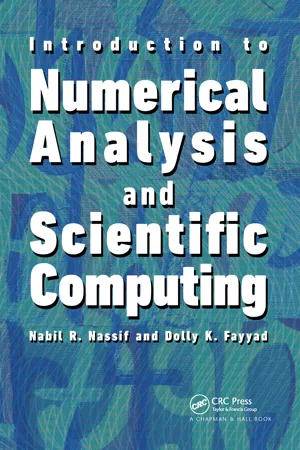
eBook - ePub
Introduction to Numerical Analysis and Scientific Computing
- 329 pages
- English
- ePUB (mobile friendly)
- Available on iOS & Android
eBook - ePub
Introduction to Numerical Analysis and Scientific Computing
About this book
Designed for a one-semester course, Introduction to Numerical Analysis and Scientific Computing presents fundamental concepts of numerical mathematics and explains how to implement and program numerical methods. The classroom-tested text helps students understand floating point number representations, particularly those pertaining to IEEE simple an
Frequently asked questions
Yes, you can cancel anytime from the Subscription tab in your account settings on the Perlego website. Your subscription will stay active until the end of your current billing period. Learn how to cancel your subscription.
At the moment all of our mobile-responsive ePub books are available to download via the app. Most of our PDFs are also available to download and we're working on making the final remaining ones downloadable now. Learn more here.
Perlego offers two plans: Essential and Complete
- Essential is ideal for learners and professionals who enjoy exploring a wide range of subjects. Access the Essential Library with 800,000+ trusted titles and best-sellers across business, personal growth, and the humanities. Includes unlimited reading time and Standard Read Aloud voice.
- Complete: Perfect for advanced learners and researchers needing full, unrestricted access. Unlock 1.4M+ books across hundreds of subjects, including academic and specialized titles. The Complete Plan also includes advanced features like Premium Read Aloud and Research Assistant.
We are an online textbook subscription service, where you can get access to an entire online library for less than the price of a single book per month. With over 1 million books across 1000+ topics, we’ve got you covered! Learn more here.
Look out for the read-aloud symbol on your next book to see if you can listen to it. The read-aloud tool reads text aloud for you, highlighting the text as it is being read. You can pause it, speed it up and slow it down. Learn more here.
Yes! You can use the Perlego app on both iOS or Android devices to read anytime, anywhere — even offline. Perfect for commutes or when you’re on the go.
Please note we cannot support devices running on iOS 13 and Android 7 or earlier. Learn more about using the app.
Please note we cannot support devices running on iOS 13 and Android 7 or earlier. Learn more about using the app.
Yes, you can access Introduction to Numerical Analysis and Scientific Computing by Nabil Nassif,Dolly Khuwayri Fayyad in PDF and/or ePUB format, as well as other popular books in Mathematics & Applied Mathematics. We have over one million books available in our catalogue for you to explore.
Information
Chapter 1
Computer Number Systems and Floating Point Arithmetic
1.1Introduction
1.2Conversion from Base 10 to Base 2
1.2.1Conversion of the Integral Part
1.2.2Conversion of the Fractional Part
1.3Conversion from Base 2 to Base 10
1.3.1Polynomial Evaluation
1.3.2Conversion of the Integral Part
1.3.3Conversion of the HYactional Part
1.4Normalized Floating Point Systems
1.4.1Introductory Concepts
1.4.2IEEE Floating Point Systems
1.4.3Denormalized Numbers in MATLAB
1.4.4Rounding Errors in Floating Point Representation
1.5Floating Point Operations
1.5.1Algebraic Properties in Floating Point Operations
1.5.2The Problem of Absorption
1.5.3The Problem of Cancellation or Loss of Precision
1.6Computing in a Floating Point System
1.6.1Cardinality and Distribution of Floating Point Systems
1.6.2A MATLAB Simulation of a Floating Point System
1.6.3Tips for Floating Point Computation
1.7Exercises
1.8Computer Projects
1.1 Introduction
The main objective of this chapter is to introduce the students to modes of storage of users’ numbers in a computer memory and as well providing the readers with basic concepts of computer arithmetic, referred to also as Floating Point Arithmetic. Although the principles covered are general and can apply to any finite precision arithmetic system, we apply those principles only to Single and Double Precision IEEE (Institute of Electrical and Electronics Engineers) systems. For additional detailed references, we refer to [8], [14], [19] and [23].
In this view, we start by describing computer number representation in the binary system that uses 2 as the base. Since the usual decimal system uses base 10, we discuss therefore methods of conversion from one base to another. The octal and hexadecimal systems (respectively, base 8 and base 16 systems) are also introduced as they are often needed as intermediate stages b...
Table of contents
- Cover
- Half Title
- Title Page
- Copyright Page
- Dedication
- Table of Contents
- Preface
- About the Authors
- List of Figures
- List of Tables
- 1 Computer Number Systems and Floating Point Arithmetic
- 2 Finding Roots of Real Single-Valued Functions
- 3 Solving Systems of Linear Equations by Gaussian Elimination
- 4 Polynomial Interpolation and Splines Fitting
- 5 Numerical Differentiation and Integration
- 6 Advanced Numerical Integration
- 7 Numerical Solutions of Ordinary Differential Equations (ODEs)
- Answers to Odd-Numbered Exercises
- Bibliography
- Index